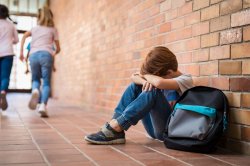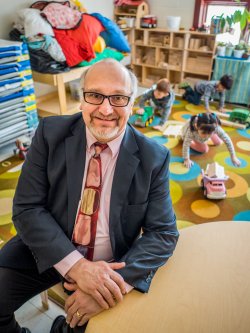Tips for Checking on Student and Teacher Health and Well-Being
Children need the chance to “tell their story” about the pandemic
Posted in: Education, Faculty Voices

Students are expected back for full-time, in-person instruction in K-12 schools this fall, and as they’re welcomed back into the classroom, school districts will have to identify and prepare for new challenges. Here, Montclair State education experts weigh in on ways school districts can address the mental and physical needs of their students to help set them up for success.

Nydia Monagas, clinical specialist, Social Work and Child Advocacy
In April 2020, calls to the [child abuse and neglect] hotline dropped by over 60% compared to April 2019. This decline was not due to a decrease in abuse; rather, abuse wasn’t being reported because children were not around the protective adults who commonly make reports, namely teachers, school counselors and other school staff. In fact, the pandemic has led to increased risk for child abuse due to job loss, isolation, and economic instability. Identifying abuse virtually is difficult.
While reports are now steadily rising since children are around more protective adults, the expectation is that once children return to school, there will be a significant influx of reports from school personnel.
As school districts prepare for the return to in-person school, it is imperative that staff review the signs and symptoms of abuse, how to respond to a child’s disclosure of abuse, and New Jersey’s mandated reporting requirements.

Sara Goldstein, professor of Family Science and Human Development
With students coming back to campuses, some level of school-based bullying will also return. Bullying in the 2021-2022 school year will likely include themes that have wreaked havoc on adults’ worlds this past year, such as the ongoing vaccination and mask wearing controversies surrounding the COVID-19 pandemic. School districts should enact efforts to make mask-wearing normalized and uncontroversial. If masks are not mandatory per state or district guidelines, the district must take pains to ensure that no child is bullied over whether they wear a mask.
Teacher and staff mental health and suicide prevention training would also be extremely beneficial, and safe spaces should be created, staffed and maintained for youth who feel marginalized.

Eva Goldfarb, professor of Public Health and expert in sex education
The pandemic reduced young peoples’ access to comprehensive sex education in schools, and reproductive health care services, contraception, STI screenings, and treatment.
There has been, however, tremendous growth in the quantity and quality of sexuality and sexual and reproductive resources online. Even before the pandemic, young people whose formal sex education was lacking – especially LGBTQ youth who are still largely excluded from curricula – were turning in increasing numbers to the internet for advice and information.
This trend is not likely to stop now that schools are reopening. While there is a downside – there is a lot of harmful, misleading and even dangerous misinformation on the internet – this presents an opportunity for districts to prioritize the teaching of media literacy, including lessons in online safety, sexting and the potential impact of pornography.
Teens in mid-to-late adolescence typically experience a sense of growing independence, increased social and peer pressure, and heightened interest in romantic relationships and sexual intimacy; adolescents returning to school and socializing may feel like they need to make up for lost time. For middle schoolers, this age is marked by the progression of puberty, as well as an increase in mixed-gender interactions and bullying – a much more challenging social atmosphere than they left in elementary school. It will be vitally important that schools provide opportunities to discuss the challenges of these developmental and social transitions, and that they understand the important role sex education plays in making them as smooth as possible.

Gerard Costa, director of the Center for Autism and Early Childhood Mental Health
The brain sciences teach us that before teachers can teach and children can learn, their stress systems need to be addressed. During COVID, children and staff have suffered illness, losses of family, colleagues and friends, and have felt less connected and more isolated. The first thing they need is the chance to “tell their story” about what has happened in their lives and how they are feeling. Most importantly, teachers need to be aware of their own verbal and non-verbal behavior (e.g. facial expressions, tone of voice, movement, pacing, etc.) Children “see” and “feel” these first.When teachers find their calm, children can be co-regulated.

Lauren Dinour, associate professor of Nutrition Science, Nutrition and Food Studies
Projections from Feeding America estimate that one in five children may have experienced food insecurity in 2020 and that one in dix children may experience food insecurity in 2021.
In the same way that schools and districts will need to be flexible with teaching modalities as COVID-19 cases fluctuate, they will also need to remain nimble in their provision of school meals. Clear and specific plans for meal distribution – during both in-person and remote instruction – should be communicated with families now to reduce food anxiety and allow households to properly budget.
There are several other ways districts and schools can address food insecurity:
- Screen for food insecurity using the Hunger Vital Sign screening tool, which identifies a household as being at risk for food insecurity.
- Partnering with local food banks and soup kitchens to increase food access for students, particularly during weekends and holidays.
- School gardens and greenhouses can provide fresh produce to students while simultaneously offering a variety of learning opportunities in an outdoor space. Grants are available for schools to start gardening programs, and container gardening can be used in schools where outdoor space is hard to find.
Kristin Scrabis-Fletcher, associate professor of Exercise Science and Physical Education
The social/emotional aspect of the pandemic is one that causes me a tremendous amount of concern, especially with students relating to each other. We are fortunate in Physical Education (PE) that we get to educate the whole child – physically, cognitively and emotionally – in a very fluid environment. The student-to-student and team interaction that takes place in the gym or on the field allows students to work cooperatively and collaboratively with others in a social setting. Not having the opportunities for these interactions over the past 17 months has taken a toll on students’ social/emotional health and well-being and how they relate to each other. As teachers, we need to be cognizant of this and foster ways early in the school year where students can work collaboratively to implement problem-solving/critical thinking strategies similar to what we see in a Cooperatives PE or Project Adventure unit.
The biggest skills PE teachers need to have/implement for the beginning of the year is patience and an open mind. Pre-assessments of students’ skills and knowledge are going to be the most useful tool they can use, so assessments of a variety of skill levels can be identified and then lessons can be tailored to meet individual needs.
To speak with one of our education experts, contact Montclair State University Media Relations.
